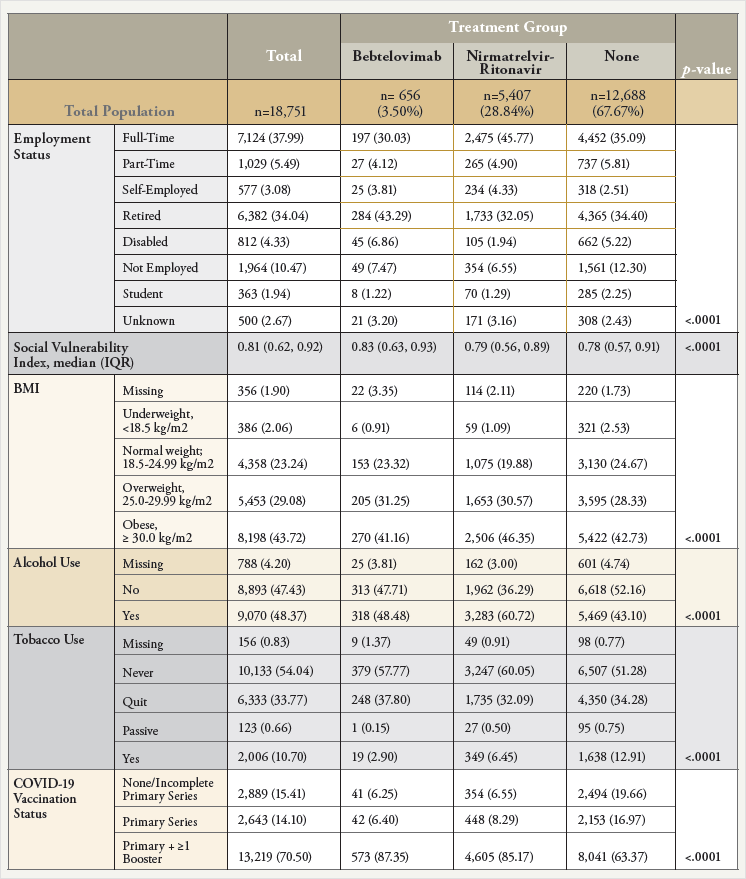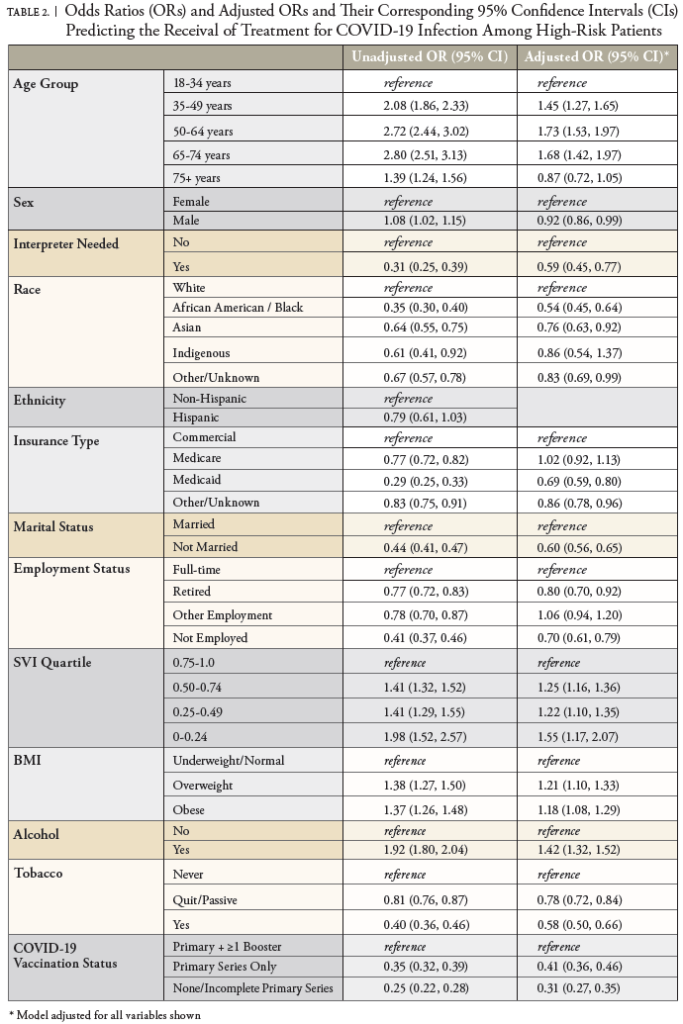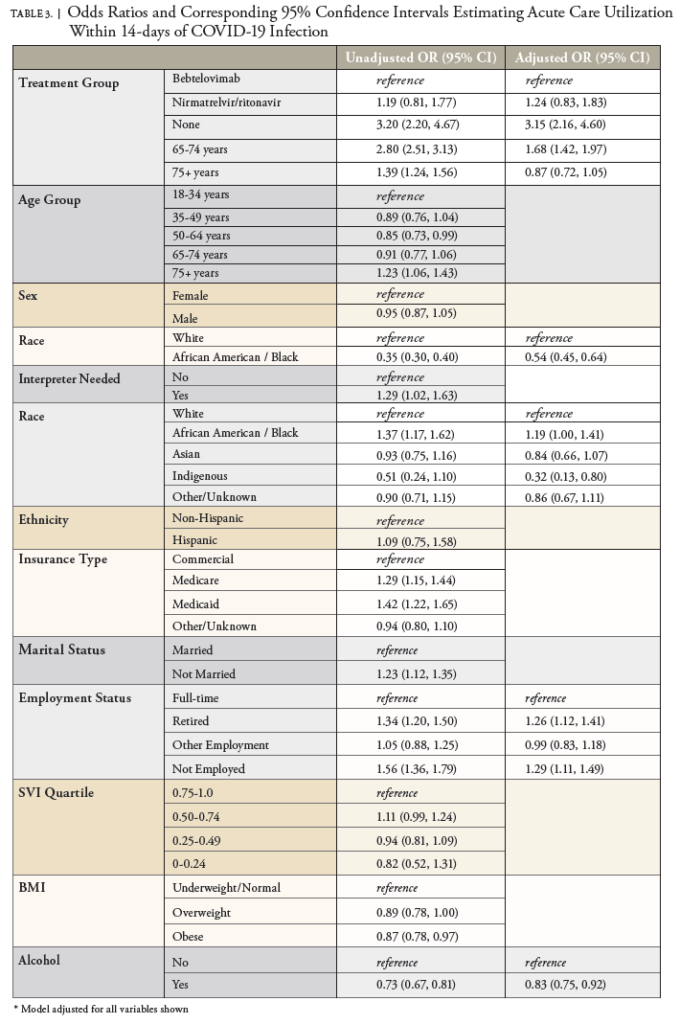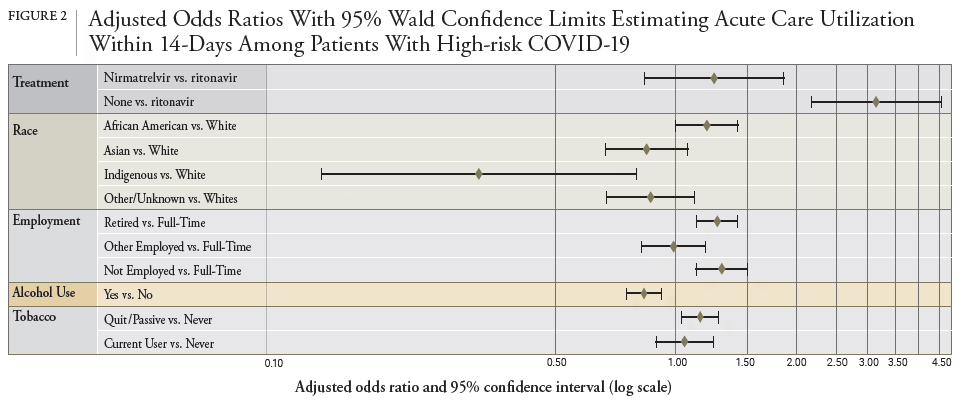1. Centers for Disease Control and Prevention. Risk for COVID-19 Infection, Hospitalization, and Death By Race/Ethnicity. Updated May 25, 2023. Accessed June 23, 2023. https://www.cdc.gov/coronavirus/2019-ncov/covid-data/investigationsdiscovery/hospitalization-death-by-race-ethnicity.html
2. Alcendor DJ. Racial disparities-associated COVID-19 mortality among minority populations in the US. Journal of Clinical Medicine. 2020;9(8):2442.
3. Boehmer TK, Koumans EH, Skillen EL, et al. Racial and Ethnic Disparities in Outpatient Treatment of COVID-19 – United States, January-July 2022. Morb Mortal Wkly Rep. Oct 28 2022;71(43):1359-1365. doi:10.15585/mmwr.mm7143a2
4. Lopez L, Hart LH, Katz MH. Racial and ethnic health disparities related to COVID-19. Jama. 2021;325(8):719-720.
5. Goldman N, Pebley AR, Lee K, Andrasfay T, Pratt B. Racial and ethnic differentials in COVID-19-related job exposures by occupational standing in the US. PloS One. 2021;16(9):e0256085.
6. Michael Gaddis S, Carey CM, DiRago NV. Changes Over Time in COVID-19 Vaccination Inequalities in Eight Large US Cities. Socius. 2023;9:23780231231161045.
7. Abrams EM, Szefler SJ. COVID-19 and the impact of social determinants of health. The Lancet Respiratory Medicine. 2020;8(7):659-661.
8. Ahmad FB, Cisewski JA, Xu J, Anderson RN. COVID-19 Mortality Update – United States, 2022. Morb Mortal Wkly Rep. May 5 2023;72(18):493-496. doi:10.15585/mmwr.mm7218a4
9. Ndugga N, Hill L, Artiga S. COVID-19 Cases and Deaths, Vaccinations, and Treatments by Race/Ethnicity as of Fall 2022. KFF. Updated Nov 17, 2022. Accessed June 23, 2023. https://www.kff.org/racial-equity-and-health-policy/issue-brief/covid-19-cases-and-deaths-vaccinations-and-treatments-by-race-ethnicityas-of-fall-2022/
10. Najjar-Debbiny R, Gronich N, Weber G, et al. Effectiveness of Paxlovid in reducing severe coronavirus disease 2019 and mortality in high-risk patients. Clinical Infectious Diseases. 2023;76(3):e342-e349.
11. Yang M, Li A, Wang Y, Tran C, Zhao S, Ao G. Monoclonal antibody therapy improves severity and mortality of COVID-19 in organ transplant recipients: a meta-analysis. Journal of Infection. 2022;85(4):436-480.
12. Chavda VP, Prajapati R, Lathigara D, et al. Therapeutic monoclonal antibodies for COVID-19 management: an update. Expert Opinion on Biological Therapy. 2022;22(6):763-780.
13. Hwang Y-C, Lu R-M, Su S-C, et al. Monoclonal antibodies for COVID-19 therapy and SARS-CoV-2 detection. Journal of Biomedical Science. 2022;29(1):1-50.
14. Centers for Disease Control and Prevention. CDC Museum COVID-19 Timeline. Updated March 15, 2023. Accessed June 23, 2023. https://www.cdc.gov/museum/timeline/covid19.html
15. U.S. Food and Drug Administration. FACT SHEET FOR HEALTHCARE PROVIDERS: EMERGENCY USE AUTHORIZATION FOR BEBTELOVIMAB Updated Nov 4, 2022. Accessed June 23, 2023. https://www.fda.gov/ media/156152/download
16. U.S. Food & Drug Administration. Paxlovid Highlights of Prescribing Information. Updated 05/2023. Accessed June 23, 2023. https://www.accessdata.fda.gov/drugsatfda_docs/ label/2023/217188s000lbl.pdf
17. Khanijahani A, Iezadi S, Gholipour K, Azami-Aghdash S, Naghibi D. A systematic review of racial/ethnic and socioeconomic disparities in COVID-19. International Journal for Equity in Health. 2021;20(1):1-30.
18. Centers for Disease Control and Prevention. Underlying Medical Conditions Associated with Higher Risk for Severe COVID-19: Information for Healthcare Professionals. Updated Feb. 9, 2023. Accessed June 23, 2023. https://www.cdc.gov/coronavirus/2019- ncov/hcp/clinical-care/underlyingconditions.html
19. Singu S, Acharya A, Challagundla K, Byrareddy SN. Impact of social determinants of health on the emerging COVID-19 pandemic in the United States. Frontiers in Public Health. 2020;8:406.
20. Bansal M, Shah M, Reilly B, Willman S, Gill M, Kaufman FR. Impact of reducing glycated hemoglobin on healthcare costs among a population with uncontrolled diabetes. Applied Health Economics and Health Policy. 2018;16(5):675-684.
21. Shah MM, Joyce B, Plumb ID, et al. Paxlovid Associated with Decreased Hospitalization Rate Among Adults with COVID-19 – United States, April-September 2022. Morb Mortal Wkly Rep. Dec 2 2022;71(48):1531-1537. doi:10.15585/mmwr.mm7148e2
22. Fagan MJ, Diaz JA, Reinert SE, Sciamanna CN, Fagan DM. Impact of interpretation method on clinic visit length. J Gen Intern Med. Aug 2003;18(8):634-8. doi:10.1046/j.1525- 1497.2003.20701.x
23. Fiscella K, Epstein RM. So much to do, so little time: care for the socially disadvantaged and the 15-minute visit. Archives of Internal Medicine. 2008;168(17):1843-1852.
24. Centers for Disease Control and Prevention. Defining Adult Overweight & Obesity. Updated June 3, 2022. Accessed June 14, 2023. https://www.cdc.gov/obesity/basics/adult-defining.html
25. Agency for Toxic Substances and Disease Registry. CDC/ATSDR Social Vulnerability Index. U.S. Department of Health & Human Services,. Updated March 15, 2022. Accessed March 18, 2022. https://www.atsdr.cdc.gov/placeandhealth/svi/index.html
26. HUD USER. HUD USPS Zip Code Crosswalk Files. Office of Policy Development and Research,. Updated Aug 2022. Accessed April 15, 2023. https://www.huduser.gov/portal/datasets/usps_crosswalk.html
27. U.S. Food & Drug Administration. FDA Approves First Oral Antiviral for Treatment of COVID-19 in Adults. Updated May 25, 2023. Accessed June 23, 2023. https://www.fda.gov/newsevents/press-announcements/fda-approves-first-oral-antiviraltreatment-covid-19-adults
28. World Health Organization. Social determinants of health. Accessed June 23, 2023. https://www.who.int/health-topics/ social-determinants-of-health#tab=tab_1
29. Braveman P, Egerter S, Williams DR. The social determinants of health: coming of age. Annual review of public health. 2011;32:381-398.
30. Kim EJ, Kim T, Conigliaro J, Liebschutz JM, Paasche-Orlow MK, Hanchate AD. Racial and Ethnic Disparities in Diagnosis of Chronic Medical Conditions in the USA. J Gen Intern Med. Jul 2018;33(7):1116-1123. doi:10.1007/s11606-018-4471-1
31. Tai DBG, Sia IG, Doubeni CA, Wieland ML. Disproportionate Impact of COVID-19 on Racial and Ethnic Minority Groups in the United States: a 2021 Update. J Racial Ethn Health Disparities. Dec 2022;9(6):2334-2339. doi:10.1007/s40615-021-01170-w
32. Rubin-Miller L, Alban C, Artiga S, Sullivan S. COVID-19 Racial Disparities in Testing, Infection, Hospitalization, and Death: Analysis of Epic Patient Data. KFF. Updated Sep 16, 2020. Accessed June 23, 2023. https://www.kff.org/coronavirus-covid-19/issue-brief/covid-19-racial-disparitiestesting-infection-hospitalization-death-analysis-epic-patientdata/
33. Irizar P, Pan D, Kapadia D, et al. Ethnic inequalities in COVID-19 infection, hospitalisation, intensive care admission, and death: a global systematic review and meta-analysis of over 200 million study participants. EClinicalMedicine. Mar 2023;57:101877. doi:10.1016/j.eclinm.2023.101877
34. Tartof SY, Malden DE, Liu IA, et al. Health Care Utilization in the 6 Months Following SARS-CoV-2 Infection. JAMA Network Open. Aug 1 2022;5(8):e2225657. doi:10.1001/ jamanetworkopen.2022.25657
35. Lewnard JA, McLaughlin JM, Malden D, et al. Effectiveness of nirmatrelvir–ritonavir in preventing hospital admissions and deaths in people with COVID-19: a cohort study in a large US health-care system. The Lancet Infectious Diseases. 2023;
36. Syed ST, Gerber BS, Sharp LK. Traveling towards disease: transportation barriers to health care access. Journal of Community Health. 2013;38:976-993.
37. National Home Infusion Association. Home Infusion: An Overview for Medicaid Programs. Accessed June 23, 2023. https://nhia.org/wp-content/uploads/2020/10/Home-Infusion-Medicaid-Advocacy-2015.pdf
38. National Home Infusion Association. Bipartisan legislation would improve home infusion access among Medicare Beneficiaries Accessed June 23, 2023. https://nhia.org/bipartisan-legislation-would-improve-home-infusion-accessamong-medicare-beneficiaries/
39. U.S. Food and Drug Administration. FDA Announces Bebtelovimab is Not Currently Authorized in Any US Region. Updated Nov 30, 2022. Accessed June 23, 2023. https://www.fda.gov/drugs/drug-safety-and-availability/fda-announcesbebtelovimab-not-currently-authorized-any-us-region







